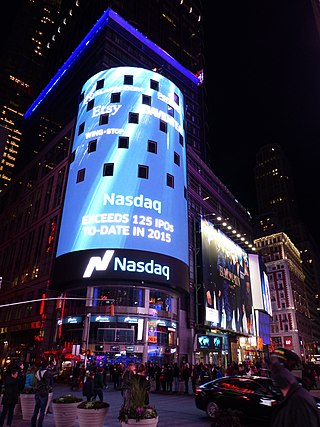
Consumer News and Business Channel Europe is a business and financial news television channel which airs across Europe. The station is based in London, where it shares the Adrian Smith-designed 10 Fleet Place building with organisations including Dow Jones & Company. Along with CNBC Asia, the channel is operated by the Singapore-headquartered CNBC subsidiary company CNBC International, which is in turn wholly owned by NBCUniversal.

HLN is an American basic cable network. Owned by CNN Worldwide, the network primarily carries true-crime programming, as well as limited live news programming.

Ticker tape was the earliest electrical dedicated financial communications medium, transmitting stock price information over telegraph lines, in use from around 1870 through 1970. It consisted of a paper strip that ran through a machine called a stock ticker, which printed abbreviated company names as alphabetic symbols followed by numeric stock transaction price and volume information. The term "ticker" came from the sound made by the machine as it printed.

CP24 is a Canadian English-language specialty news channel owned by Bell Media, a subsidiary of BCE Inc. and operated alongside the Bell-owned CTV Television Network's owned-and-operated television stations CFTO-DT and CKVR-DT. The channel broadcasts from 299 Queen Street West in Downtown Toronto.

CTV News Channel is a Canadian specialty news channel owned by Bell Media. It broadcasts national and international news headlines, breaking news, and information. The channel is headquartered at 9 Channel Nine Court in the Agincourt neighbourhood of Scarborough in Toronto, Ontario.
Sportsnet 360 (SN360) is a Canadian discretionary specialty channel owned by Rogers Media. The channel was launched in 1994 as the licence-exempt service Sportscope, which featured a display of sports news and scores. In 1997, the network was re-launched under Canadian Radio-television and Telecommunications Commission (CRTC) licensing as Headline Sports, adding anchored segments to its rolling sports news programming. In 2000, the network gained the ability to air occasional broadcasts of live sporting events, and was re-launched as The Score. In 2012, the network's parent company Score Media announced that it would sell the network to Rogers Communications, which owns the competing Sportsnet family of sports television networks; in 2013, the network was re-branded as Sportsnet 360.

A character generator, often abbreviated as CG, is a device or software that produces static or animated text for keying into a video stream. Modern character generators are computer-based, and they can generate graphics as well as text.

In the television industry, a lower third is a graphic overlay placed in the title-safe lower area of the screen, though not necessarily the entire lower third of it, as the name suggests.

The Nasdaq MarketSite is the commercial marketing presence of the Nasdaq stock market. Located at Times Square in the Midtown Manhattan neighborhood of New York City, it occupies the northwest corner at the base of the 4 Times Square skyscraper.

Bloomberg Television is an American-based pay television network focusing on business and capital market programming, owned by diversified information and media private company Bloomberg L.P. It is distributed globally, reaching over 310 million homes worldwide. It is headquartered in New York City, with European headquarters in London and Asian headquarters in Marina Bay Financial Centre, Singapore and Pacific Place Jakarta, Sudirman Central Business District, Jakarta.

Worldwide Exchange is a television business news program on CNBC channels around the world. It used to be broadcast live from studios on three continents until May 11, 2012. The programme is anchored by Frank Holland and is produced at CNBC Global Headquarters in Englewood Cliffs, New Jersey. Prior to January 4, 2016, it was produced by CNBC Europe in London.
The Chyron Corporation, formerly ChyronHego Corporation, headquartered in Melville, New York, is a company that specializes in broadcast graphics creation, playout, and real-time data visualization for live television, news, weather, and sports production. Chyron's graphics offerings include hosted services for graphics creation and order management, on-air graphics systems, channel branding, weather graphics, graphics asset management, clip servers, social media and second screen applications, touchscreen graphics, telestration, virtual graphics, and player tracking.

The Financial News Network (FNN) was an American financial and business news television network that was launched November 30, 1981. The purpose of the network was to broadcast programming nationwide, five days a week for seven hours a day on thirteen stations, in an effort to expand the availability of business news for public dissemination. FNN was founded by Glen H. Taylor, a former minister of the Christian Church from 1950 to 1956, and producer of films for the California Department of Education. The channel was purchased by NBC in February 1991, and operations were integrated with rival cable financial news network, CNBC, on May 21, 1991.

BNN Bloomberg is a Canadian English language discretionary specialty channel owned by Bell Media. It broadcasts programming related to business and financial news and analysis. The channel is headquartered at 299 Queen Street West in Downtown Toronto.

RR Media was a NASDAQ listed provider of global digital media services to the broadcast industry and content owners. Its services can be divided into four main groups: global content distribution network ; content management & playout; sports, news & live events; and online video services.

BandNews TV is a Brazilian 24-hour television news channel, owned by Grupo Bandeirantes. It was the second news channel launched in the Brazilian cable/satellite market.
BottomLine is ESPN's lower third sports information ticker. It is uniform in design and used on all ESPN networks. It displays current sports scores, stats, and headlines in a 'push-then-scroll' format. It also serves as a display for urgent information, such as breaking sports news, breaking significant national news from ESPN sister networks ABC and FX, updated scores, a rain delay notification, or the move of a game from one ESPN network to another. BottomLine is also used on the TSN channels in Canada and on the Latin American and Brazilean ESPN channels.

A television news screen layout or television news screen interface refers to the layout image displayed during a television news program broadcast. The layouts used differ between television stations and countries, and information displayed may include things such as main news topics and headlines within the lower third, channel logos, a news ticker, a time clock, and in some cases weather and stock market information.
The American cable and satellite television network Pop was originally launched in 1981 as a barker channel service providing a display of localized channel and program listings for cable television providers. Later on, the service, branded Prevue Channel or Prevue Guide and later as Prevue, began to broadcast interstitial segments alongside the on-screen guide, which included entertainment news and promotions for upcoming programs. After Prevue's parent company, United Video Satellite Group, acquired the entertainment magazine TV Guide in 1998, the service was relaunched as TV Guide Channel, which now featured full-length programs dealing with the entertainment industry, including news magazines and reality shows, along with red carpet coverage from major award shows.
The Motograph News Bulletin, also known as the Zipper, was a 380 feet long electromechanical news ticker display that wrapped around One Times Square.


















